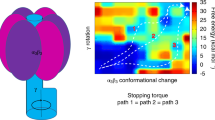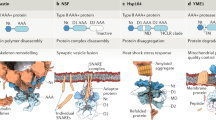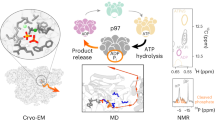Abstract
AAA+ proteins carry out diverse functions in cells. In most cases, their ATPase activity is tightly regulated by protein partners and target ligands, but the mechanism for this control has remained unclear. We have identified a conserved link between the ligand binding and ATPase sites in AAA+ proteins. This link, which we call the 'glutamate switch', regulates ATPase activity directly in response to the binding of target ligands by controlling the orientation of the conserved glutamate residue in the DExx motif, switching it between active and inactive conformations. The reasons for this level of control of the ATPase activity are discussed in the context of the biological processes catalyzed by AAA+ proteins.
This is a preview of subscription content, access via your institution
Access options
Subscribe to this journal
Receive 12 print issues and online access
$189.00 per year
only $15.75 per issue
Buy this article
- Purchase on Springer Link
- Instant access to full article PDF
Prices may be subject to local taxes which are calculated during checkout





Similar content being viewed by others
References
Kunau, W.H. et al. Two complementary approaches to study peroxisome biogenesis in Saccharomyces cerevisiae: forward and reversed genetics. Biochimie 75, 209–224 (1993).
Neuwald, A.F., Aravind, L., Spouge, J.L. & Koonin, E.V. AAA+: a class of chaperone-like ATPases associated with the assembly, operation, and disassembly of protein complexes. Genome Res. 9, 27–43 (1999).
Iyer, L.M., Leipe, D.D., Koonin, E.V. & Aravind, L. Evolutionary history and higher order classification of AAA+ ATPases. J. Struct. Biol. 146, 11–31 (2004).
Erzberger, J.P. & Berger, J.M. Evolutionary relationships and structural mechanisms of AAA+ proteins. Annu. Rev. Biophys. Biomol. Struct. 35, 93–114 (2006).
Browning, D.F. & Busby, S.J. The regulation of bacterial transcription initiation. Nat. Rev. Microbiol. 2, 57–65 (2004).
Ahnert, P., Picha, K.M. & Patel, S.S. A ring-opening mechanism for DNA binding in the central channel of the T7 helicase-primase protein. EMBO J. 19, 3418–3427 (2000).
Yoder, B.L. & Burgers, P.M. Saccharomyces cerevisiae replication factor C. I. Purification and characterization of its ATPase activity. J. Biol. Chem. 266, 22689–22697 (1991).
Seybert, A. & Wigley, D.B. Distinct roles for ATP binding and hydrolysis at individual subunits of an archaeal clamp loader. EMBO J. 23, 1360–1371 (2004).
Klemm, R.D., Austin, R.J. & Bell, S.P. Coordinate binding of ATP and origin DNA regulates the ATPase activity of the origin recognition complex. Cell 88, 493–502 (1997).
Walker, J.E., Saraste, M., Runswick, M.J. & Gay, N.J. Distantly related sequences in the α- and β-subunits of ATP synthase, myosin, kinases and other ATP-requiring enzymes and a common nucleotide binding fold. EMBO J. 1, 945–951 (1982).
Mogk, A. et al. Roles of individual domains and conserved motifs of the AAA+ chaperone ClpB in oligomerization, ATP hydrolysis, and chaperone activity. J. Biol. Chem. 278, 17615–17624 (2003).
Joly, N., Rappas, M., Wigneshweraraj, S.R., Zhang, X. & Buck, M. Coupling nucleotide hydrolysis to transcription activation performance in a bacterial enhancer binding protein. Mol. Microbiol. 66, 583–595 (2007).
Rappas, M., Schumacher, J., Niwa, H., Buck, M. & Zhang, X. Structural basis of the nucleotide driven conformational changes in the AAA+ domain of transcription activator PspF. J. Mol. Biol. 357, 481–492 (2006).
Abrahams, J.P., Leslie, A.G., Lutter, R. & Walker, J.E. Structure at 2.8 Å resolution of F1-ATPase from bovine heart mitochondria. Nature 370, 621–628 (1994).
Sallai, L. & Tucker, P.A. Crystal structure of the central and C-terminal domain of the σ54-activator ZraR. J. Struct. Biol. 151, 160–170 (2005).
Lee, S.Y. et al. Regulation of the transcriptional activator NtrC1: structural studies of the regulatory and AAA+ ATPase domains. Genes Dev. 17, 2552–2563 (2003).
Rappas, M. et al. Structural insights into the activity of enhancer-binding proteins. Science 307, 1972–1975 (2005).
Chaney, M. et al. Binding of transcriptional activators to sigma 54 in the presence of the transition state analog ADP-aluminum fluoride: insights into activator mechanochemical action. Genes Dev. 15, 2282–2294 (2001).
Bowman, G.D., O'Donnell, M. & Kuriyan, J. Structural analysis of a eukaryotic sliding DNA clamp-clamp loader complex. Nature 429, 724–730 (2004).
Seybert, A., Singleton, M.R., Cook, N., Hall, D.R. & Wigley, D.B. Communication between subunits within an archaeal clamp-loader complex. EMBO J. 25, 2209–2218 (2006).
Gaudier, M., Schuwirth, B.S., Westcott, S.L. & Wigley, D.B. Structural basis of DNA replication origin recognition by an ORC protein. Science 317, 1213–1216 (2007).
Dueber, E.L., Corn, J.E., Bell, S.D. & Berger, J.M. Replication origin recognition and deformation by a heterodimeric archaeal Orc1 complex. Science 317, 1210–1213 (2007).
Zhang, X. et al. Structure of the AAA ATPase p97. Mol. Cell 6, 1473–1484 (2000).
Matias, P.M., Gorynia, S., Donner, P. & Carrondo, M.A. Crystal structure of the human AAA+ protein RuvBL1. J. Biol. Chem. 281, 38918–38929 (2006).
Bochtler, M. et al. The structures of HsIU and the ATP-dependent protease HsIU-HsIV. Nature 403, 800–805 (2000).
Trame, C.B. & McKay, D.B. Structure of Haemophilus influenzae HslU protein in crystals with one-dimensional disorder twinning. Acta Crystallogr. D Biol. Crystallogr. 57, 1079–1090 (2001).
Davies, J.M., Brunger, A.T. & Weis, W.I. Improved structures of full-length p97, an AAA ATPase: implications for mechanisms of nucleotide-dependent conformational change. Structure 16, 715–726 (2008).
Schlee, S., Groemping, Y., Herde, P., Seidel, R. & Reinstein, J. The chaperone function of ClpB from Thermus thermophilus depends on allosteric interactions of its two ATP-binding sites. J. Mol. Biol. 306, 889–899 (2001).
Hattendorf, D.A. & Lindquist, S.L. Cooperative kinetics of both Hsp104 ATPase domains and interdomain communication revealed by AAA sensor-1 mutants. EMBO J. 21, 12–21 (2002).
Singleton, M.R. et al. Conformational changes induced by nucleotide binding in Cdc6/ORC from Aeropyrum pernix. J. Mol. Biol. 343, 547–557 (2004).
Erzberger, J.P., Pirruccello, M.M. & Berger, J.M. The structure of bacterial DnaA: implications for general mechanisms underlying DNA replication initiation. EMBO J. 21, 4763–4773 (2002).
Yoo, S.J. et al. Purification and characterization of the heat shock proteins HslV and HslU that form a new ATP-dependent protease in Escherichia coli. J. Biol. Chem. 271, 14035–14040 (1996).
Dean, F.B. et al. Simian virus 40 (SV40) DNA replication: SV40 large T antigen unwinds DNA containing the SV40 origin of replication. Proc. Natl. Acad. Sci. USA 84, 16–20 (1987).
Gai, D., Zhao, R., Li, D., Finkielstein, C.V. & Chen, X.S. Mechanisms of conformational change for a replicative hexameric helicase of SV40 large tumor antigen. Cell 119, 47–60 (2004).
White, P.W. et al. Characterization of recombinant HPV6 and 11 E1 helicases: effect of ATP on the interaction of E1 with E2 and mapping of a minimal helicase domain. J. Biol. Chem. 276, 22426–22438 (2001).
Joly, N., Burrows, P.C. & Buck, M. An intramolecular route for coupling ATPase activity in AAA+ proteins for transcription activation. J. Biol. Chem. 283, 13725–13735 (2008).
Schepers, A. & Diffley, J.F. Mutational analysis of conserved sequence motifs in the budding yeast Cdc6 protein. J. Mol. Biol. 308, 597–608 (2001).
Sollner, T., Bennett, M.K., Whiteheart, S.W., Scheller, R.H. & Rothman, J.E. A protein assembly-disassembly pathway in vitro that may correspond to sequential steps of synaptic vesicle docking, activation, and fusion. Cell 75, 409–418 (1993).
Rappas, M., Bose, D. & Zhang, X. Bacterial enhancer-binding proteins: unlocking σ54-dependent gene transcription. Curr. Opin. Struct. Biol. 17, 110–116 (2007).
Collaborative Computational Project, Number 4. The, CCP4 suite: programs for protein crystallography. Acta Crystallogr. D Biol. Crystallogr. 50, 760–763 (1994).
Acknowledgements
This work was funded by the Wellcome Trust and Biotechnology and Biological Sciences Research (X.Z.) and Cancer Research UK (D.B.W.).
Author information
Authors and Affiliations
Corresponding authors
Rights and permissions
About this article
Cite this article
Zhang, X., Wigley, D. The 'glutamate switch' provides a link between ATPase activity and ligand binding in AAA+ proteins. Nat Struct Mol Biol 15, 1223–1227 (2008). https://doi.org/10.1038/nsmb.1501
Received:
Accepted:
Published:
Issue Date:
DOI: https://doi.org/10.1038/nsmb.1501
This article is cited by
-
ATP-binding and hydrolysis of human NLRP3
Communications Biology (2022)
-
Assessing heterogeneity in oligomeric AAA+ machines
Cellular and Molecular Life Sciences (2017)
-
Nucleotide-dependent assembly of the peroxisomal receptor export complex
Scientific Reports (2016)
-
Identification and characterization of multiple rubisco activases in chemoautotrophic bacteria
Nature Communications (2015)
-
Molecular snapshots of the Pex1/6 AAA+ complex in action
Nature Communications (2015)



